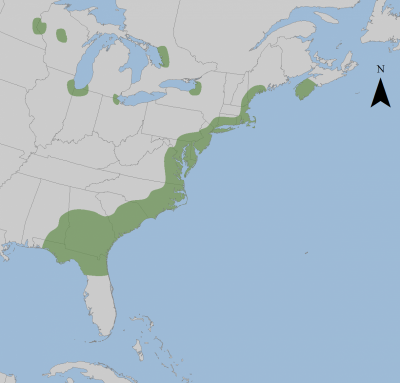
The Atlantic Coastal Plain started forming about 100 million years ago when the Mid-Atlantic Ridge began expanding the Atlantic Ocean. For millions of years, the Appalachian Mountains eroded and many rivers and streams deposited sediments along much of the eastern coast of North America. In some places, these sediments are over 10 km thick! This formed a flat landscape that lies between the Piedmont (just below the mountains) and the ocean, from New Jersey to Florida. Given millions of years and the fairly consistent availability of flat, often wet habitats, many hundreds of species of plants have adapted to and thrive along this coastal plain.
The last 2.5 million years have been characterized by a series of glacial periods, the last of which peaked about 22,000 years ago when all of current Nova Scotia was covered by very thick ice. This glacial period ended about 12,500 years ago and a few thousand years later, Nova Scotia was free of ice. With sea-levels as much as 100 m lower than today's, and with a relatively warm climate, many coastal plain species migrated north either across a smaller (<150 km) gap between Cape Cod and southern Nova Scotia, or to New Brunswick and back south. Even though southwest Nova Scotia is not technically part of the Atlantic Coastal Plain, its climate, geology, and glacial history support some of the best coastal plain-like habitat in all of North America.
This group of plants is well-adapted to living in areas where many other plants cannot survive and are regularly subject to disturbance by wind, waves, ice, and changing water levels. They do not compete well with other more aggressive plants and therefore can not establish in undisturbed, fertile areas. ACPF are often found on exposed, gently sloping, sandy or gravel lake shores in addition to a number of other habitats.